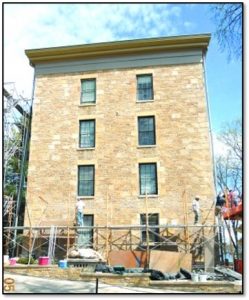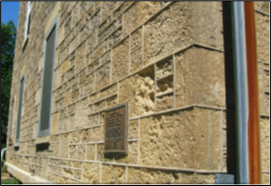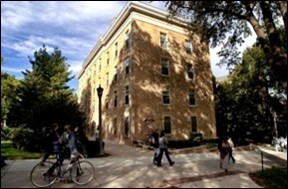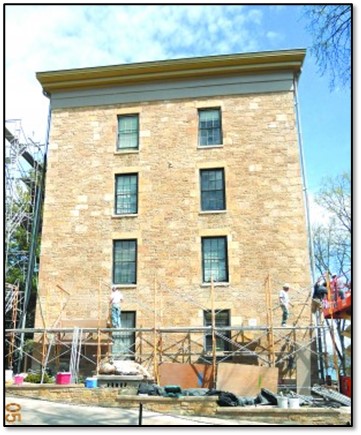Client: University of Wisconsin – Madison
Reference Contact 1: Project Manager – QA, Division of State Facilities
Reference Contact 2: Project Architect, Isthmus Architecture
Construction Budget: $4.5 Million
Masonry Restoration and Preservation
The University of Wisconsin – Madison Campus, North and South Halls, ca. 1851 in Madison, Wisconsin.Speweik Preservation Consultants (SPC) was asked to provide a stone-by-stone survey to identify the preservation treatment approach and restoration plan according to the specification requirements. SPC assisted the architect in establishing the drawings and specifications for the Madison sandstone restoration treatments on both buildings. A full and complete test panel was installed prior to contractor bidding. This allowed the owner an opportunity to pre-approve a section of the wall to establish the workmanship standards. A reliable budget was established from this preconstruction test panel and bidders were introduced to the level of quality the architect and owner expected prior to submitting their pricing.
Historic sandstone preservation treatments included: redressing stone insitu; removing stone; redressing and returning to the same location; removal and replacement; consolidation of sandstone with injection grout; substitute stone repair; dispersed hydrated lime crack injection; mechanical and non mechanical Dutchman stone repair techniques; and repointing mortar joints with lime putty mortar. The project started February 2010 and was completed in October 2011. An American Society for Testing and Materials (ASTM) E2659-09 Historic Stone Masonry Training Program was developed specifically for the historic sandstone preservation treatments which corresponded to the requirements of the Department of the Interior’s Standards for Rehabilitation.
The ASTM E2659-09 Historic Stone Masonry Training in the Removal and Replacement of Sandstone.
Skilled masons make repairs to 150-year-old North, South halls | Wisconsin State Journal
Masons working on North Hall, a National Historic Landmark, had to undergo a rigorous training program led by Chicago masonry preservation specialist John Speweik. The workers are being careful to preserve as much of the original stone as possible.
Two of UW-Madison’s oldest buildings are being painstakingly restored this summer with historic masonry work that has drawn crowds. The university is spending $2 million to make repairs to North Hall, built in 1851, and South Hall, built in 1855. North Hall, the first building on campus, originally housed the entire university — classrooms, labs and dorm space — until South Hall was built. Today, North Hall houses the political science department and South Hall is office space. But both buildings were in trouble.
Wide cracks had erupted in the walls; water accumulated behind the faces of the stones, and holes had opened. Over the years, the buildings had been repaired using a type of cement that damaged the original stone, said Laura Davis of Isthmus Architecture, who was asked to assess damage and oversee restoration work. Since North Hall is a National Historic Landmark, its restoration and that of its neighbor, across from it on Bascom Hill, were priorities.
“We decided we wouldn’t just look at the lowest bid,” Davis said. They wanted to find (masons) “who could prove they have the skill and the conscientiousness to work on buildings like this.” She turned to Chicago historical masonry preservation specialist John Speweik, who has worked in post-Katrina New Orleans. “This kind of work is totally different than putting up block walls,” Davis said. “There’s a vast difference between old and new building materials.” Masons who were to work on the buildings were required to go through rigorous training programs led by Speweik, who then evaluated their work before letting them loose on the buildings. “We did whatever we could to save the original stone,” Davis said. That included saving the carved graffiti in the sills, which dates to the 1870s.




